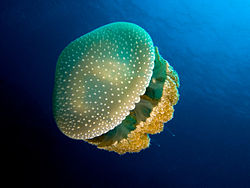- Phyllorhiza punctata
-
Phyllorhiza punctata 
Phyllorhiza punctata off the north coast of Haiti Scientific classification Kingdom: Animalia Phylum: Cnidaria Class: Scyphozoa Order: Rhizostomae Family: Mastigiidae Genus: Phyllorhiza Species: P. punctata Binomial name Phyllorhiza punctata Phyllorhiza punctata is a species of jellyfish, also known as the Australian spotted jellyfish or the White-spotted jellyfish. It is native to the southwestern Pacific, where it feeds primarily on zooplankton. P. punctata average 45-50 cm in bell diameter but there had been a maximum reported size of 62 cm. However, in October, 2007, one 72 cm. wide, perhaps the largest ever recorded, was found on Sunset Beach, NC. In July 2007 smaller ones were seen in Bogue Sound much further north along the North Carolina Coast. They have only a mild venom and are not considered a threat to humans. However, their ability to consume plankton and the eggs and larvae of important fish species is cause for concern. Each jellyfish can filter as much as 13,200 gallons of sea water per day. While doing that, it ingests the plankton that native species need.
Since at least 2000[1], Phyllorhiza punctata has been found in large numbers in Gulf of Mexico. While it is not known how it was introduced to the region, it has been theorized that budding polyps may have attached themselves to ships[2], or gotten carried in a ship's ballast tank[3] which was subsequently dumped in the Gulf. As an invasive species, it has become a threat to several species of shrimp. In Gulf waters, the medusae grow to unusually large size, upward of 60cm across. The Australian Spotted Jellyfish has a mild or non noticeable sting which can be cured with vinegar. Salt water can be used as a last resort.
The species has also been found in the waters off the Hawaiian Islands since at least 1945[4], but have not experienced the same type of massive population explosion found in the Caribbean and the Gulf of Mexico. The ecological impact of the species in those waters has not been determined. It has been spotted off the Southern California coast, but not confirmed[5].
True jellyfish, Phylum Cnidaria, go through a two stage life cycle which consists of a medusa stage (adult) and a polyp stage (juvenile). In the medusa stage male jellyfish release sperm into the water column and the female jellyfish gathers the sperm into her mouth where she holds the eggs. Once fertilization occurs and larvae are formed they leave their mother and settle to the ocean floor. Once on the bottom a polyp form occurs and this form reproduces asexually by “cloning” or dividing itself into other polyps. Jellyfish can live for up to five years in the polyp stage and up to two years in the medusa stage.
When found in warm waters these jellyfish flourish. They are mostly euryhaline but low salinities may have a negative effect on the species. In times of low salinity these jellyfish exhibit loss of their zooxanthellae[6].
-
Phyllorhiza punctata in Berlin Zoological Garden
-
Phyllorhiza punctata in Universeum, Gothenburg.
References
 Media related to Phyllorhiza punctata at Wikimedia Commons
Media related to Phyllorhiza punctata at Wikimedia Commons- White-spotted Jellyfish Fact File, Australia Museum Online
- Invasive Aquatic Species - Spotted Jellyfish, Elkhorn Slough Research
- Phyllorhiza punctata, Dauphin Island Sea Lab
- A Survey of the Relationship of the Australian Spotted Jellyfish, Phyllorhiza punctata, and OCS Platforms
- Guidebook to the Introduced Marine Species of Hawaii, Bishop Museum and the University of Hawaii
- NAS - Nonindigenous Aquatic Species - Phyllorhiza punctata, USGS
- Invasion of the Jellies, California Academy if Sciences
- [7], Smithsonian Marine Station at Fort Pierce
External links
- Species Profile- White Spotted Jellyfish (Phyllorhiza punctata), National Invasive Species Information Center, United States National Agricultural Library. Lists general information and resources for White Spotted Jellyfish.
Categories:- Rhizostomeae
-
Wikimedia Foundation. 2010.



